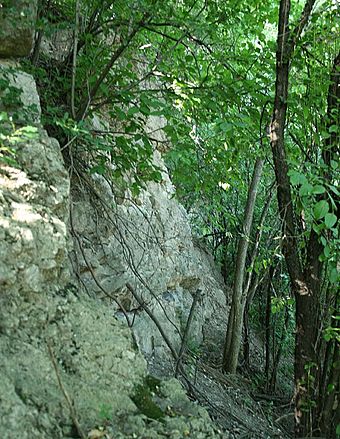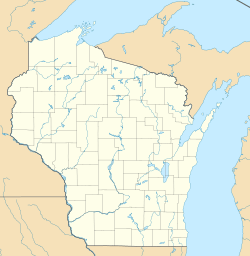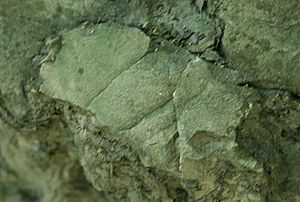Schoonmaker Reef facts for kids
|
Schoonmaker Reef
|
|
 |
|
| Location | Wauwatosa, Wisconsin |
|---|---|
| NRHP reference No. | 97001266 |
Quick facts for kids Significant dates |
|
| Added to NRHP | September 25, 1997 |
| Designated NHL | September 25, 1997 |
Schoonmaker Reef is an amazing fossilized reef in Wauwatosa, Wisconsin. It is also known by names like Wauwatosa Reef or Francey Reef. This ancient reef is incredibly old, about 425 million years old!
Two explorers, Increase A. Lapham and Fisk Day, discovered it in 1844. They found it at a quarry owned by the Schoonmaker family. A famous geologist, James Hall, said it was very important in 1862. It was the first ancient reef ever studied in North America. It was also one of the first in the whole world!
You can find it in Wauwatosa, Wisconsin, near W. State Street. The reef became a National Historic Landmark in 1997. Visitors can explore the reef to learn about its past and how it formed.
Contents
How the Reef Formed
The Schoonmaker Reef started forming around 425 million years ago. This was during a time called the Silurian period. The reef is mostly made of a rock called dolomite. Dolomite is a sedimentary rock. It is similar to limestone. It contains calcium and magnesium carbonate.
This reef is part of a larger rock layer called the Racine Dolomite. This layer is found in Wisconsin and Illinois. The part of the reef you can see is in the Menomonee River valley. It looks like a huge rock hill. This rock hill stretches for about 600 feet.
The exposed part of the reef is at the bottom 20 feet of a 60-foot bluff. The top part of the bluff is made of dirt and rocks. These were left behind by glaciers millions of years ago. The reef has many different fossils. These fossils are from creatures that lived during the Silurian period. You can even find trilobites there!
History of Discovery
People first started using the reef in 1838. Joseph Higgins found it was a good source of lime. Lime was used for building and other things. Lime burning might have started even earlier, around 1833. Silas Brown built special ovens called lime kilns in the 1840s. These kilns were used until 1857.
Increase A. Lapham was the first to see the reef as a special geological site. He noted its importance in 1844.
Studying the Reef
John Schoonmaker and Isaac W. Van Schaick bought the land in 1857. Schoonmaker ran the quarry until 1909. That is why the reef is named after him. In 1862, James Hall officially named Schoonmaker Reef. He said it was the first ancient reef found on mainland North America.
Lapham had sent Hall fossils from the reef. This helped Hall learn about the site. Hall often visited Lapham in Milwaukee, Wisconsin in the 1850s. He wanted to see Lapham's amazing fossil collection. Hall made Schoonmaker Reef a main focus of his studies. It became a key example for understanding how ancient reefs grew.
Thomas Chrowder Chamberlin was the Wisconsin State Geologist. He studied the reef in 1877. He compared it to reefs that exist today. Chamberlin said Schoonmaker Reef was important because it had so many fossils.
Fossil Collectors
Many amateur geologists also collected fossils from the reef. These included Thomas A. Greene and Fisk Holbrook Day. Day's collection was very important. It had samples from about 200 different species. His work helped identify about 90% of the reef's species.
Alexander Emanuel Agassiz bought most of Day's collection in 1881. This huge collection weighed over 4 tons! It went to the Museum of Comparative Zoology at Harvard University. Day also sold thousands of fossils to Greene for his museum. After Day's death, 10,000 more fossils went to the University of Michigan.
William C. Alden took pictures of the reef in 1899. These pictures were used in many geology textbooks. In 1904, Amadeus William Grabau wrote a paper about the reef. It was published in a science journal.
Later Years
The G. D. Francey Coal, Stone & Supply Company bought the land in 1909. They used the quarry to make aggregate. Aggregate is material like sand and gravel used in construction.
Robert Rakes Shrock wrote a paper about Wisconsin reefs in 1939. He included the Schoonmaker Reef in his study. He was the first to draw a full diagram of the reef's layers. In 1948, the Bliffert Concrete Company bought the quarry. They stopped using it two years later.
In recent years, an apartment building was built near the reef site. It is even named The Reef!
See also




